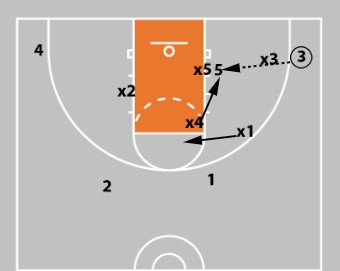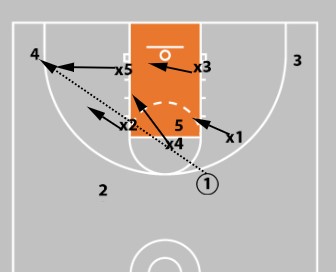3-2 Basketball Zone Defense
The 3-2 zone is a commonly played zone that can be highly effective. Let’s take a look!
To get FREE 3-2 Zone Encyclopedia, click the banner below
- Strengths
- Weaknesses
- Personnel Considerations
- Rotations
- Trapping Options
- Skip Pass Rules
- Dribble Penetration Rules
- Rebounding Rules
- Zone Defense Coaching Resources
Strengths of the 3-2 Zone Defense
- Effectively covers the middle - most zones are vulnerable in the middle. This zone positions a player in that area, limiting the offense’s ability to attack that area.
- Trapping options - the 3-2 is a zone that you can trap out of white not overextending your defense. It allows you to try to force turnovers without being overly exposed.
- Limits dribble penetration - there are not many driving gaps in a 3-2 zone. Played correctly, teams have to pass effectively to generate good shots.
Weaknesses Of The 3-2 Zone Defense
- Weak side rebounding - sometimes you are left with one player responsible for rebounding the weak side. Since this is where most misses go, that can make you susceptible to offensive rebounds.
- Lack of ball pressure - because the middle defender plays back, the point guard has the chance to patiently survey the defense.
- Bottom defense can be screened in - some teams will try to overload by screening the bottom defenders. Those players must be tough and be able to fight through screens.
Lineup Considerations & Player Placement For The 3-2 Zone Defense

- X1 & X2 are your guards. Since most shots come from the right side, put your best rebounding guard where x2 is.
- X4 should be a taller player. If your 5 can move, this is a good spot for them, as they can take away passes and remain within 15’ of the basket. It can also be an athletic forward.
- X3 & X5 are usually forwards/posts. They generally have to cover block to corner (with one exception). As with X2, put your best rebounding forward where X5 is (on the left side).
Rotations & How To Play The 3-2 Zone Defense
Ball Up Top
Most teams will attack a 3-2 zone with an even front zone offense (2 guards).

- The ball side guard (x1) positions themselves on 1’s outside shoulder and attempts to play between 1 and the corner player (3). This makes the pass to 3 difficult.
- The opposite guard and forward (x2 & x5 ) start to move towards the lane line since they are on the weak side of the floor.
- X4 wants to be both on the line between 1 and the rim and in the passing lane to the high post.
- X3 is positioned on the block but thinking about covering the corner. They can’t cheat early and leave the block open. If the offense had a player on the block, x3 needs to be in front of them to take away the pass and also prevent them from being screened in.
Ball In The Corner

- On every corner pass, the bottom defenders move in tandem. The ballside forward (x3) takes the ball in the corner. The weak side forward (x5) comes across to the vacated ball side block.
- The ball side guard (x1) drops into the gap. (You could also have x1 stay wide and deny thee pass back to 1).
- X4 drops to the mid post and takes away any center pass.
- X2 drops to box out the weak side on a shot. They will also cover any skips.
Alternate Corner Coverage

- If you have a immobile big that you want to keep close to the basket, you can have the wings cover the corners.
- On a skip, x2 sprints and closes out on the corner. X4 slides into the gap.

- One advantage of this coverage is it keeps your best rebounders and biggest players closer to the rim.
High Post Coverage

- The ball should not get to the middle. However, it will happen. When it does, x4 should turn and harass 5 from behind to try to make them uncomfortable.
- X5 & x3 should stunt and fake towards 5. They can’t full out commit to 5 or the player in their corner can cut for a layup. Additionally, many high post players are not effective shooters, so don’t overreact. The forwards want to create indecision from 5.
- The guards (x1 & x2) should start to fan out to take any kick out pass and try to prevent a rhythm 3.
Trapping From The 3-2 Zone Defense
There are 2 primary trapping options in the 3-2 zone.
Corner Trap

- On the pass to the corner, x1 & x3 trap.
- X4 rotates over to deny the reversal pass to 1.
- 5 comes across. If there is a player on the block, 5 should front them.
- X2 comes across to take away the mid post.

- If the trap is good, 3 should not be able to throw a skip. If they do, x2 will take the first pass to the weak side.
Post Trap

- You can also trap the post. You can trap with almost any defender, but x4 (your top middle defender) is your best bet. Trapping with them allows you to bring a second defender with size, limiting passing options.
- X3 denies the pass back to the corner.
- X1 & x2 split the other 3 offensive players and read 5’s shoulders for a sign of where they are going to pass.

Skip Pass Rules For The 3-2 Zone Defense
Beyond the rotations, here are a couple other 3-2 zone rules:

- The forwards take skips to the corner.

- The guards take skips to the wing.
Dribble Penetration Rules For The 3-2 Zone Defense

- On dribble penetration from the top, the middle defender and the guard come together to prevent a split.

- If a split does occur, the forward stops the ball and the guard fans out to the ball side corner.

- In the 3-2, you generally want to force penetration to the middle. As you can see in the picture above, there is a lot of help in the middle, making drives difficult.
Rebounding Rules For The 3-2 Zone Defense

- On a shot, there should always be a rebounding triangle. In this scenario, if 3 shot from the corner, x2, x4, & x5 would form a rebounding triangle. X1 should look to read the shot and attack the ball.

- If 1 shot from the top, the rebounding triangle would be x3, x4, & x5. X2 would likely box out x2 and x1 would pursue the ball.
Helpful Zone Defense Videos and Resources
- 2-3 Zone Defense With Al Marshall - in recent years, zones have been making a comeback. Why? Because they are hard to play against. Coach Marshall covers his zone, which produced some of the stingiest defense in Iowa high school basketball. Whether you have tall and long players who are perfect for the 2-3, or are running it because your team is physically overmatched, Coach Marshall shows you the rotations and principles of an elite zone team. His teaching style is tremendous, allowing you to easily teach this zone and give opponents fits.
- The 31 Defense With Will Rey - the 1-3-1 zone is a defense most coaches don’t like to play against. So why not run it yourself? Coach Rey will teach you how to install and run the 1-3-1 with varying levels of aggressiveness. Part of its effectiveness is how you can come after people and trap in the 1-3-1, or play back and force low percentage shots. Coach Rey covers all of that and more. Adding this as your primary defense or as a secondary defense is a great way to take your opponent out of their comfort zone.
- Don Kelbick’s Matchup Zone Defense - A good matchup zone is a nightmare to play against. What holds most coaches back from teaching one is the perceived difficulty of teaching it. Don Kelbick teaches you an effective matchup zone that players will understand and be able to execute. He also goes over how to extend and trap out of it, making the defense a Swiss Army Knife!
To get FREE 3-2 Zone Encyclopedia, click the banner below
|
|||||||||||||||||||||||||||||||||||||||

.png)


 Facebook (145k Followers)
Facebook (145k Followers) YouTube (152k Subscribers)
YouTube (152k Subscribers) Twitter (33k Followers)
Twitter (33k Followers) Q&A Forum
Q&A Forum Podcasts
Podcasts